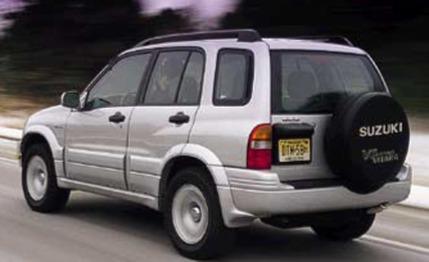
 Long-Term Road Test
Long-Term Road Test
In May 1998, we published a comparison of five "Little Land Bruisers," all competitors to the Suzuki Grand Vitara, which could have been the sixth vehicle in that test of sub-$21,000 entry-level sport-utility vehicles but for the fact that it wasn't introduced here until 1999. The Subaru Forester L won that test, and we still have a soft spot for its lower center of gravity and more carlike moves. We're car guys, after all, as you've heard us intone over the years. Not that we can't try to love a trucklet or appreciate its load-carrying versatility. But when the old push comes to shove, we want to zip around, not labor in something that moves like a pickup.
While we were learning to love the Grand Vitara, we had a lot of fun with its unusual name. No, it's not the first vehicle with a peculiar name to come down the Hogback trail, but it did arrive about the time Viagra hit the pharmacies, so there was no end to the Vitara/Viagra jokes. Our favorite moniker came from contributor "Uncle Fred" Gregory. He described the Grand Vitara as an "extraterrestrial potentate." Move over, Baron Harkhonen!
Well, funny name and funny vehicle in many respects. The new-for-'99 Grand Vitara, and its Chevrolet-badged Tracker sibling, retain their truckish body-on-frame heritage, but Suzuki took pains to increase the refinement level of these little trucklets so that they might better defend against the wave of car-based mini-utes such as the Toyota RAV4 and the Honda CR-V.
The 2.5-liter dual-overhead-cam 24-valve V-6 engine that comes standard in the Grand Vitara (and is unavailable in the Tracker until 2001) is the most convincing gesture along those lines. It produces 155 horsepower and 160 pound-feet of torque, which means it would have overpowered all the land bruisers but the Forester, which had a flat-four with 165 hp. The four other four-cylinder mini-utes had horsepower ranging from 125 to 130. Based on initial acceleration runs of our long-term Vitara, it would have run out in front of that pack. And after 40,000 miles, all acceleration numbers were improved (the 50-to-70-mph top-gear run was quicker by a full second). The Vitara's 0.72-g skidpad grip would have tied the leader, and only the CR-V would have outbraked its 192-foot stops from 70 mph.
But sometimes the test numbers don't tell the whole story. The Grand Vitara was not a great joy around town or on the highway. Interstate runs did little to flatter this V-6, which somehow manages to sound as coarse as a Ford pushrod 4.0-liter. Some drivers had to look underhood to be sure it was a DOHC V-6, as it seemed unhappy winding out to the redline. We were grateful for the five-speed manual rather than the optional four-speed automatic.
If the Suzuki's refinement trailed that of the mini-ute leaders, at least the truck parts paid off. John Phillips took the Vitara off-roading and reported "very little chassis flex, very little rattle of subassemblies, minimal steering kickback, minimal vibration up through the rack, pedals, or shift linkage."
Much of what we write about our long-term cars has to do with what we spend on service and maintenance. The total service cost for the Grand Vitara JLX+ was $781, which was unusually high.
But let's regress a moment and give the good news first. The Vitara used but one quart of oil throughout 40,000 miles, it required no unscheduled service or repair, and the only "normal wear" item was $16 worth of wiper blades.
Back to the scheduled service: Suzuki's inspection and maintenance schedule for the Grand Vitara is ambitious. At 7500-mile intervals, it calls for not only the usual replacement of engine oil and filter and a tire rotation but also multiple inspections of such items as the brake discs, the suspension and steering systems, and all hinges, latches, and locks. Every 15,000 miles, the inspectors delve deeper still, checking the propeller shafts; the wheel bearings; and the disc, drum, and parking brake systems.
Our first pit stop at 7500 miles was $85 for a tire rotation, replacement of the engine oil and filter, and the required inspections. A more typical cost on other vehicles for a 7500-mile service with fewer inspections would be on the order of $30. The 15,000-, 22,500-, and 37,500-mile inspections were $87, $98, and $85, respectively -- again, higher than usual.